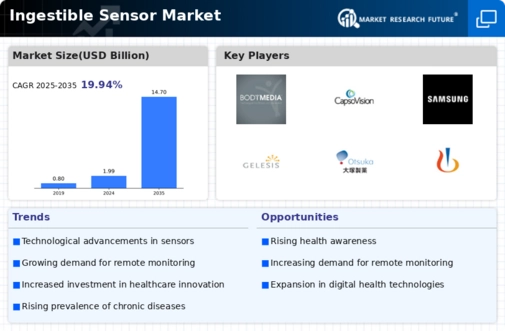Growing Prevalence of Chronic Diseases
The Ingestible Sensor Market is significantly influenced by the increasing prevalence of chronic diseases such as diabetes, cardiovascular disorders, and gastrointestinal conditions. These diseases necessitate continuous monitoring and management, which ingestible sensors can facilitate effectively. For instance, ingestible sensors can track medication adherence and physiological parameters, providing valuable insights for both patients and healthcare providers. The World Health Organization has reported that chronic diseases account for approximately 71% of all deaths globally, underscoring the urgent need for innovative monitoring solutions. As healthcare systems strive to manage these conditions more effectively, the demand for ingestible sensors is expected to rise, thereby propelling growth within the Ingestible Sensor Market. This trend may also lead to increased investment in research and development to enhance sensor capabilities.
Advancements in Miniaturization Technology
The Ingestible Sensor Market is benefiting from advancements in miniaturization technology, which have enabled the development of smaller, more efficient sensors. These technological innovations allow for the creation of ingestible devices that can monitor various health parameters without compromising patient comfort. As sensors become smaller and more sophisticated, they can be integrated into a wider range of applications, from drug delivery systems to diagnostic tools. The miniaturization trend is likely to enhance the appeal of ingestible sensors among both consumers and healthcare providers, as they offer a seamless and unobtrusive way to monitor health. Furthermore, the market for miniaturized medical devices is projected to grow at a compound annual growth rate of 8.5% through 2027, indicating a favorable environment for the Ingestible Sensor Market to thrive.
Rising Demand for Remote Patient Monitoring
The Ingestible Sensor Market is experiencing a notable surge in demand for remote patient monitoring solutions. As healthcare systems increasingly prioritize patient-centric care, ingestible sensors offer a non-invasive method to collect real-time health data. This technology enables healthcare providers to monitor patients' conditions remotely, potentially reducing hospital visits and improving patient outcomes. According to recent estimates, the market for remote patient monitoring is projected to reach USD 2.5 billion by 2026, indicating a robust growth trajectory. The integration of ingestible sensors into these systems enhances the accuracy and reliability of health data, thereby fostering greater trust among patients and providers alike. This trend is likely to drive further innovation within the Ingestible Sensor Market, as stakeholders seek to develop more sophisticated and user-friendly solutions.
Increased Investment in Healthcare Technology
The Ingestible Sensor Market is poised for growth due to increased investment in healthcare technology. Governments and private entities are recognizing the potential of innovative technologies to improve patient care and reduce healthcare costs. This influx of capital is facilitating the development of advanced ingestible sensors that can provide real-time health monitoring and data analytics. For instance, venture capital investments in health tech have surged, with estimates suggesting a total investment of over USD 20 billion in 2025. This financial support is likely to accelerate the pace of innovation within the Ingestible Sensor Market, as companies strive to bring cutting-edge solutions to market. As a result, the landscape of healthcare is expected to evolve, with ingestible sensors playing a pivotal role in transforming patient management.
Regulatory Support for Innovative Medical Devices
The Ingestible Sensor Market is experiencing favorable conditions due to regulatory support for innovative medical devices. Regulatory bodies are increasingly recognizing the importance of ingestible sensors in enhancing patient care and are streamlining approval processes to encourage innovation. This supportive regulatory environment is likely to facilitate the introduction of new ingestible sensor technologies, thereby expanding the market. For example, the Food and Drug Administration has implemented initiatives to expedite the review of breakthrough medical devices, which could significantly benefit the Ingestible Sensor Market. As regulations evolve to accommodate advancements in technology, manufacturers may find it easier to bring their products to market, fostering competition and driving further advancements in sensor capabilities.

















Leave a Comment